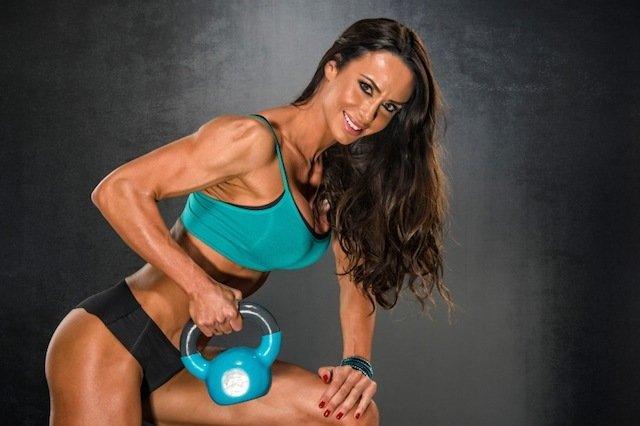

Woman's Kettlebell Fat Loss Program
Table of Contents
Kettlebell Fat Loss Program for Women
By Craig Marker, PhD
Kettlebells are a great tool for fat loss and strength gains. They are a simple piece of equipment that are portable. As Pavel Tsatsouline said years ago in Muscle Media, “kettlebells are an ancient Russian tool against weakness.” This program will help you build strength and lose fat. The kettlebell will be used, but alternatives will be given.
The Science
I would like to tell you to skip down if you don’t want to read about how this program works. I can’t. It is good to know how it works, so you are not tempted to change it based on your feelings. The goal of this program is to avoid the burn. The burn is associated with hard work and hard work with results. This program allows you to work hard without the burn and achieve even greater results. Thus, in this program, your feelings don’t matter. I am not trying to be disrespectful. It is that the program may not feel challenging, but it is optimizing your energy systems for maximum fat loss and muscle gain.
So a bit of background on your energy systems. It has been divided into three main systems, but all systems engage at the same time:
- The alactic system

This is your turbo burst system. It supplies a quick intense supply of energy. It runs out quickly. You primarily rely on this system when you do sprints or lift heavy weights. At times it has been called the anaerobic (without oxygen) system. Without getting too heavy into the mechanics of this system, it relies on your storage of creatine phosphate. Mitochondria turns creatine into fuel. Taking creatine helps this system, but your body can only store so much. In this program, we want to maximize this system. We want to make it as efficient as possible so you can lift heavier weights.
- The glycolytic system

This system is the in-between system. It is both anaerobic and aerobic and it is optimal in the middle distance. You would feel it if you tried to sprint for as long as you could or if you do over 15 reps of an exercise. This is the burn that is popular in high intensity programs. It provides a satisfactory feeling as you feel you have ‘worked out’. Our goal is to ‘train’ the body and not to ‘work it out’.
The glycolytic system works well in the short term to help the body burn fat. It relies on the stress response. The neuroendocrine system kicks in during stress and utilizes our resources. This response comes at a cost to our body. Over time, this stress can cause damage to mitochondria (we want more of these not less). Additionally, this system relies on glucose to create creatine phosphate molecules. We want our bodies to learn to burn fat for fuel. There are also signs that relying on glycolysis for long periods of time leads to more risk of injury. The glycolytic system is to be avoided in this program.
- The aerobic system

This is the long term system that relies primarily on fat sources for fuel. If this system is fully trained, we can go for hours using this system. It is highly efficient, but low in power. Lance Armstrong spent a great deal of his off-season training this system to be as efficient as possible and to rely on his fat stores. In races, the glycolytic system is needed, but in the off-season he wanted to make the fat burning system as efficient as possible so he would be strong in sprints. It also kept his body from breaking down from being too often in glycolysis. We are going to do this as well.
Al Ciampa, working with Pavel Tsatsouline, has called this program the A+A program. It uses the two outside energy systems and avoids the middle glycolytic system. We want to harness
the fat burning aerobic system to replenish the quick alactic system. This program does not rely on one hour treadmill sessions. Rather, we are going to train our bodies to use the alactic system, back off before we get too glycolytic, and then let the aerobic system replenish our creatine phosphate stores. Basically, we push to the edge of discomfort and then retreat to fight again later.
The Program
For this program, you will do 3 days of conditioning and 3-4 days of strength training. In this article, I am only discussing the conditioning piece. You are allowed to do strength training as you desire. You can combine strength training and conditioning on the same days. I suggest that you start the day with this conditioning program as you will be able to burn fat more efficiently.

Conditioning will consist of one exercise, the kettlebell swing. You could adapt this program to running stairs, sprinting, or jumping rope. I like the kettlebell swing as it builds explosive lower body power. The program consists of doing about 15 seconds of work followed by 45 seconds of rest. For sprints, you would sprint at 85% effort for 15 seconds and then rest for 45 seconds. You will repeat every minute on the minute. As you begin the program, you will do it for ten minutes (and only ten minutes). It might feel easy (and it should). Don’t be tempted to do more. We are allowing the alactic system to go at full speed and then let the aerobic system refill our creatine phosphate stores. We do not want to make it a glycolytic workout. You will not feel the burn and you will not have to collapse to the ground after this training. If you do, then you might have done it incorrectly.
Here is the layout for your workouts
-10 kettlebell swing every minute on the minute
-3 days a week for 6 weeks.
-Make one day longer than the other two (e.g., Mon 10 minutes, Wednesday 14 minutes, Friday 12 minutes).
-Each week try to add two minutes to your average time (do not go over 30 minutes)
-The talk test can be used to make sure the rest is long enough. If you can talk comfortably before the next set, then you are okay. If you are too out of breath to talk, then you need to add more rest in between sets.
Here is a table of a sample program (10 swings every minute on the minute)
| Monday | Wednesday | Friday | |
| Week 1 | 10 minutes | 14 | 12 |
| Week 2 | 12 | 16 | 14 |
| Week 3 | 14 | 18 | 16 |
| Week 4 | 16 | 20 | 18 |
| Week 5 | 18 | 22 | 20 |
| Week 6 | 20 | 24 | 22 |
The Swing
Step 1. Hinge don’t squat
The swing is an easy exercise that is done wrong in so many popular media sources. It is not a squat movement, rather it is a hip hinge movement. That means that the hips go back (hinge) more than the knees. The knees only bend slightly (the bend fully in a squat). The easiest way to think about it is a jump. If you try to jump as high as you can, the bottom position is the same position that you use at the bottom of the kettlebell swing. (Note: heavy kettlebell swings are an a great tool for building explosive jumping power).
Step 2. Be explosive with the hips, not the arms.
The swing is a ballistic movement. If we think of a bullet fired out of a gun, it receives all of its power initially and then relies on momentum to get to its destination. The same goes for the swing. The hips provide the explosive power throwing the kettlebell up in the air. The arms are there just for the ride. Do not worry about how high the kettlebell goes. Your goal is to let it float up once the hips have used up their power.
Step 3. Protect the back
There are two primary ways to protect the back in this movement. The first is to engage the lats. What that means is to pull the shoulders back and down. I like to approach the kettlebell like a gorilla with my arms out. This position brings my shoulders back and down. I try to hold that position throughout the movement and not let my shoulders round my upper back. By keeping my upper back tight, I provide more protection to my lower back.
The second key to protecting the back is to not let the kettlebell pull the lower back into a bad position at the bottom of the swing. You can accomplish this by having the kettlebell go between your legs on your upper thighs. As Dave Whitley has said, it is like playing chicken with your man or lady parts. At the last second you hinge back to let the kettlebell go between your upper thighs. If you find your forearms hitting your lower thighs, you are putting too much strain on the lower back.
How heavy?
If you are proficient with your swing and do the proper movement, heavier weight will use up more of your alactic system. For extremely strong gentlemen I suggest a 32kg (70lb), for strong ladies a 20kg (about 44lbs). For strong individuals a 24kg for men and 16kg for women will work fine. Adjust the weight according to your experience and proficiency with the kettlebell. If you do not feel comfortable, then short sprints and stair climbing might be a better alternative.
Summary
The goal of this fat burning program is to create a fat burning environment that also allows one to become stronger. If you feel like you are bored or this program is too easy, then you are probably doing it correctly. Please do not get tempted to shorten time intervals to ‘feel’ the burn. In this program your feelings do not matter. You do not need to feel the burn and in many ways you want to avoid it.
MUSCLE MEDIA MAGAZINE FOR WOMEN
The premier source of training, nutrition, supplements, fat loss and health for women.

















